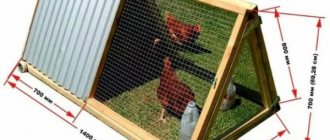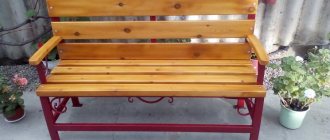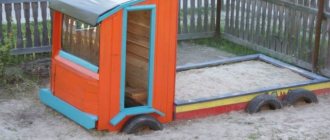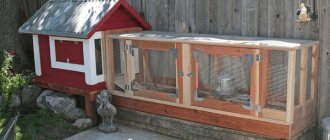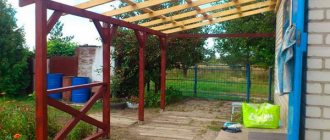A greenhouse is an indispensable thing for every gardener. Seedlings and early crops are grown in it. In a store, such a structure costs a lot of money.
To save money, you can build it yourself. There are many types of greenhouses that you can build yourself without spending money on consumables.
Required material
What can a greenhouse cover be made from:
- polyethylene;
- lutrasil;
- spunbond;
- polycarbonate;
- glass.

The frame for a greenhouse comes in various shapes: in the form of an arc, a triangle, a house, etc. It can be made from polypropylene profiles, iron or fiberglass reinforcement, beams, window frames.
Greenhouse forms
The frame shape can be any:
- arched shape;
- triangular design;
- rectangular shape.

Each form is good in its own way. The choice of form is up to the owner of the site, since only he can determine which option is more acceptable for him.
Preparatory work
Before building a greenhouse made of polycarbonate or any other material, you need to calculate the following:
- How much area can be allocated for construction?
- Functionality of the structure: will it be needed all year round or only in the spring. The construction of the first option will take more effort and time, because Heating, lighting, water, and a ventilation system will be needed.
- Suitable type, material of manufacture, etc.
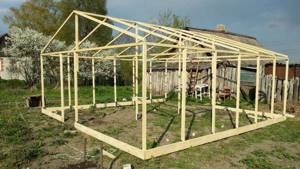
How to plant zucchini in a greenhouse
By installing a stationary heated greenhouse, vegetables can be harvested all year round. The lightweight design for the warm period brings the fruiting period closer and extends it until autumn. Growing zucchini in a polycarbonate greenhouse has become most widespread. Transparent material provides sufficient illumination and reliable protection from external influences. The structure is heated by a wood stove or electric heaters. To get a rich harvest, gardeners need to take care of several conditions:
- prepare fertile soil;
- solve the watering problem;
- feed the plants at least 3 times during the growing season;
- provide a comfortable microclimate.

The first thing you need to take care of is to arrange the beds and fill them with fertile soil. The frame protecting the earth from spilling is made of boards. For zucchini, neutral, loose soil, generously fertilized with organic matter and mineral elements, is recommended. Peat, humus and sawdust are added to loamy soil. Quite poor sandy soil needs to be fertilized with manure, peat or compost. Mineral fertilizers are applied at the rate of 1 m2: superphosphates 30 g, urea 20 g, potassium sulfate 15-20 g, ash 100 g. Rules for soil preparation in the article “The zucchini harvest will not keep you waiting if you start planting correctly.”
Advice. To prevent diseases, water the beds with a solution of potassium permanganate (1 g per 10 liters of water).
Compact bush varieties are chosen for the greenhouse. Hybrids that do not require pollination are recommended: “Kuand”, “Kavili”, “Iskander”, “Belogor”. The varieties are distinguished by the F1 marking. Hybrids grow quickly, are characterized by productivity, and do not depend on pollination by insects. In high greenhouses you can plant climbing varieties by arranging vertical supports. Is it possible to plant zucchini seedlings or is it better to plant seeds? The seedling method is more common; seedlings take root well and bear fruit early.
Advice. When allocating space in the greenhouse, give the zucchini a southern exposure so that they get enough sunlight.
Planting seeds for seedlings begins 1 month before transplanting into the greenhouse. You will need peat pots or separate plastic cups. You can use fertile soil prepared in the garden beds or buy special soil in the store. Zucchini seeds have good germination, but it is better to pre-soak them in a solution of a growth stimulator. After germination, seedlings are kept in a well-lit place. During the first week, the temperature is adjusted between: 20-22°C during the day, 16-17°C at night.
The width of the greenhouse beds is 80-100 cm, a passage of at least 50 cm is arranged between them. Holes are dug for the seedlings at a distance of 70-80 cm from each other. Before planting seedlings, the soil is irrigated with warm water. The seedlings are buried up to the first leaves. Planting of seedlings occurs using a strip or square-cluster method. A popular method is to use manure as heating. Cow or horse manure mixed with straw is laid out on the beds. 20-25 cm of soil is poured on top. When decomposed, manure releases a lot of heat, and it is also the best fertilizer for zucchini.
Caring for vegetables indoors
After planting seedlings, it is necessary to provide the plants with favorable climatic conditions. The optimal temperature for growing zucchini indoors is 24-26°C during the day and 14-15°C at night. Humidity should not exceed 70%. Unlike other vegetables, zucchini needs frequent ventilation. The greenhouse design must have vents. Watering vegetables should be done 2 times a week. The water taken is warm; cold liquid leads to disease and weakening of the culture.
Advice. In stationary greenhouses, the optimal irrigation option is drip irrigation. It provides the plant with the necessary amount of moisture.
Mulching helps suppress weed growth and reduce moisture loss. The soil around the vegetables is covered with peat, humus, and hay. Care includes regular fertilizing of the crop. To enter it is used:
- solution of mullein (1:10) or chicken manure (1:20) with water;
- complex mineral fertilizer “Nitroammofoska”;
- infusion of wood ash (200 g per bucket of water);
- potassium humate;
- superphosphates.
Pollination
When planting conventional varieties, it is necessary to provide access for insects to pollinate the flowers. They enter the greenhouse through open windows and doors. Experienced farmers use one trick: spray the bushes with a solution of honey (1 teaspoon per 1 liter of water). Sweet syrup attracts insects. The fruits are harvested 7-10 days after the formation of the ovary.
Advice. If the foliage on the bushes grows strongly, some of the leaf blades should be removed. This will provide access to light and heat to the fruit.
Types of greenhouses
Structures can be permanent or collapsible. Among the huge selection of greenhouse projects, each owner of a plot of land will choose the most suitable one.
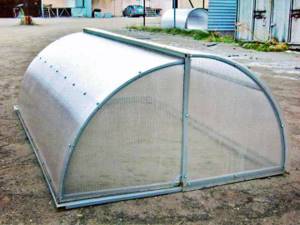
The most convenient and popular designs:
Thermos. The peculiarity of this type is that its body is completely immersed in the ground. Only the lid remains on the surface. Thanks to this, the greenhouse retains heat longer.

Breadbox. Opening the lid follows the principle of a kitchen utensil with the same name. With one movement of the hand, it tips over to the back wall and also returns to its original position.
We recommend reading:
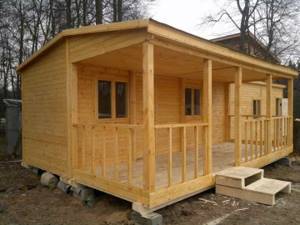
How to make a utility block for a dacha - a step-by-step description of how to build it yourself and instructions for arranging a utility block (115 photos)
How to build a bathhouse from timber - 125 photos of the best projects and ideas on how to build a bathhouse correctly
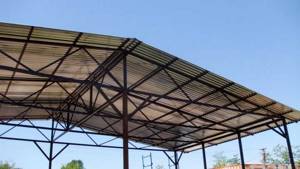
Do-it-yourself canopy: step-by-step description of how to build a canopy correctly. The best ideas and beautiful design options (95 photos)

Arc greenhouse. The simplest design in terms of installation and dismantling. The frame is attached to the ground and covered with plastic film or a similar material with similar performance characteristics.
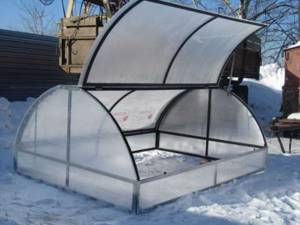
House. This is a raised gable roof. It is easy to construct: 2 battens are connected and fastened at the ridge. The frame can be covered with glass, polycarbonate or other heat-insulating material.
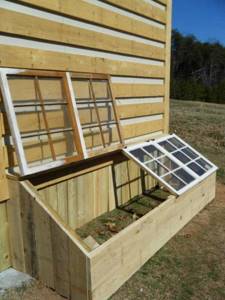
Butterfly. It has doors that open outwards. Thanks to this, you can approach the greenhouse from any direction.
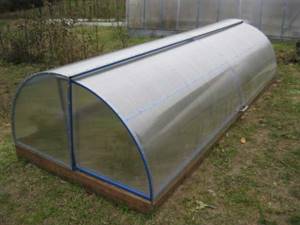
Let's consider the process of constructing a greenhouse for a bread bin.
Greenhouse concept
A small room for growing plants and protecting them from bad weather, where heating is not provided, is called a greenhouse.
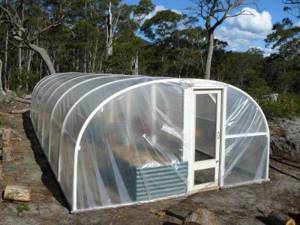
The greenhouse design has a transparent side fence and the same removable roof. This allows the sun's rays to freely penetrate the room without burning the tender seedlings with scorching rays.

Greenhouse bread box
You need to find drawings on the Internet. They will indicate the exact dimensions of the greenhouse. After this, you can begin construction.
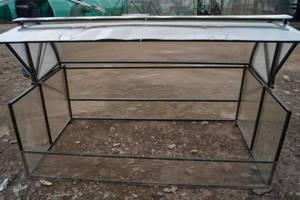
We recommend reading:

Beautiful canopy over the porch - installation options, design options and installation tips (95 photos)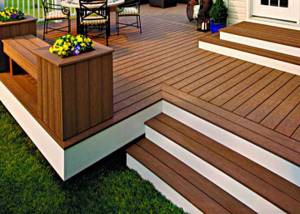
How to attach a terrace to a house - step-by-step description of the construction, design options, projects and installation instructions (115 photos)
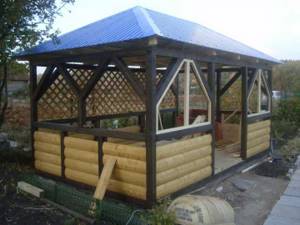
Building a gazebo with your own hands - the best design ideas and main stages of construction (115 photos + video)
Advantages
Why is the bread box greenhouse better than other models:
- the opening top simplifies the operation process;
- there is no need to create new paths to access the structure (it can be approached from any side);
- due to its lightness and small size, it can be periodically moved to a new location;
- ease of assembly.
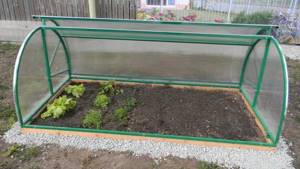
Required Tools
Standard set of tools:
- screwdriver;
- drill with a cross-shaped nozzle;
- crosshead screwdriver;
- wrench No. 10;
- construction knife;
- level;
- roulette.

Assembly
Step by step steps:
- Carefully study the photo of the greenhouse drawing with your own hands, and use it to install the frame on a flat area. It is advisable to install it with the long part on the south side. This way the seedlings will get more sun.
- A bread bin does not require a foundation. It is fixed to the ground with strong pins or wooden beams and metal corners are used as support.
- Secure the lintels of the structure with screws.
- Cover the frame with heat-insulating material (thickness of at least 4 mm), secure it with self-tapping screws.
- If the roof is removable, it must be secured to a special bushing or hinges on the sides as a last resort.
- Place the handles for opening and closing on the screws.
- To reduce the gap between the cover and the frame, you can use a self-adhesive seal.
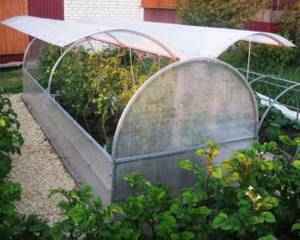
Such a greenhouse retains heat perfectly, even if there is a small gap left.

Make a greenhouse “Zucchini” from polycarbonate with your own hands
Did you want to assemble the structure yourself? In this case, you must first choose a place where the greenhouse will stand .
a concrete foundation as the base . After this, draw the drawings according to which you will assemble it.
Focus on making a greenhouse from cellular polycarbonate .
Assembly instructions are as follows:
- When fastening, polycarbonate sheets must be oriented with the protective layer facing outward. If this is not observed, the greenhouse’s service life will be significantly reduced. When you lay the sheets, be sure to remove the protective film.
- When installing, polycarbonate cells must be positioned vertically.
- Before installing the ends of the sheets, remove them from the packaging.
- The sheets are fastened with roofing screws with a diameter of five millimeters. There should be a distance of 500 - 800 millimeters between them. This depends on the thickness of the sheet.
The "Zucchini" greenhouse has both advantages and disadvantages. However, with a skillful approach, the latter turn into advantages. Installing such a structure yourself is not difficult.
The need to build a greenhouse
A greenhouse provides invaluable assistance in growing vegetables and many plants. Heat-loving plants need relatively stable temperatures. If they are planted in open ground, then night spring frosts can destroy the plant.

Greenhouses protect plants from scorching sun rays, strong gusts of wind and rain. Thanks to the greenhouse, excellent harvests of early ripening varieties of vegetables are grown.

Greenhouse design options
Nowadays, many different schemes and designs of greenhouses and greenhouses have been invented and invented. All of them are good for a certain area, a certain greenhouse design or wallet. We will look at several common and successful options.
Soil-film greenhouse
There are, for example, soil-film greenhouses, consisting of only one film, which covers the beds. This type is suitable for growing seedlings or when using soil with a large amount of nitrates. Only low-growing crops, such as greens or radishes, can be permanently grown under film. Usually, when using soil-film greenhouses, the beds are made 25-30 cm wide. The beds should have the same height if the covering material is supported by trellises. If the film lies directly on the ground, then the height of the greenhouse should be at least 40 cm.
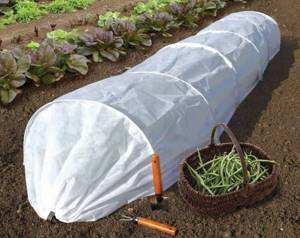
Here is an example of a soil-film greenhouse with a small trellis Source ogorod-bez-hlopot.ru
The advantages of this type of greenhouse include their low cost and simplicity. They are often constructed from improvised materials. But at the same time, soil-film greenhouses do not use sunlight well, and also limit access to the crops planted under them.
Types of greenhouses
Currently, there are many types of greenhouses. The types of greenhouses depend on the tasks they perform and on the shape of the structure.
Greenhouses are divided according to heating temperature:
- warm greenhouses, this is for growing plants that require increased heat (up to 18 degrees) and moisture, like tropical plants;
- semi-cold greenhouses, in which the air temperature is maintained at 12-13 degrees;
- cold greenhouses, their task is to harden plants accustomed to low temperatures (for example, onions).







